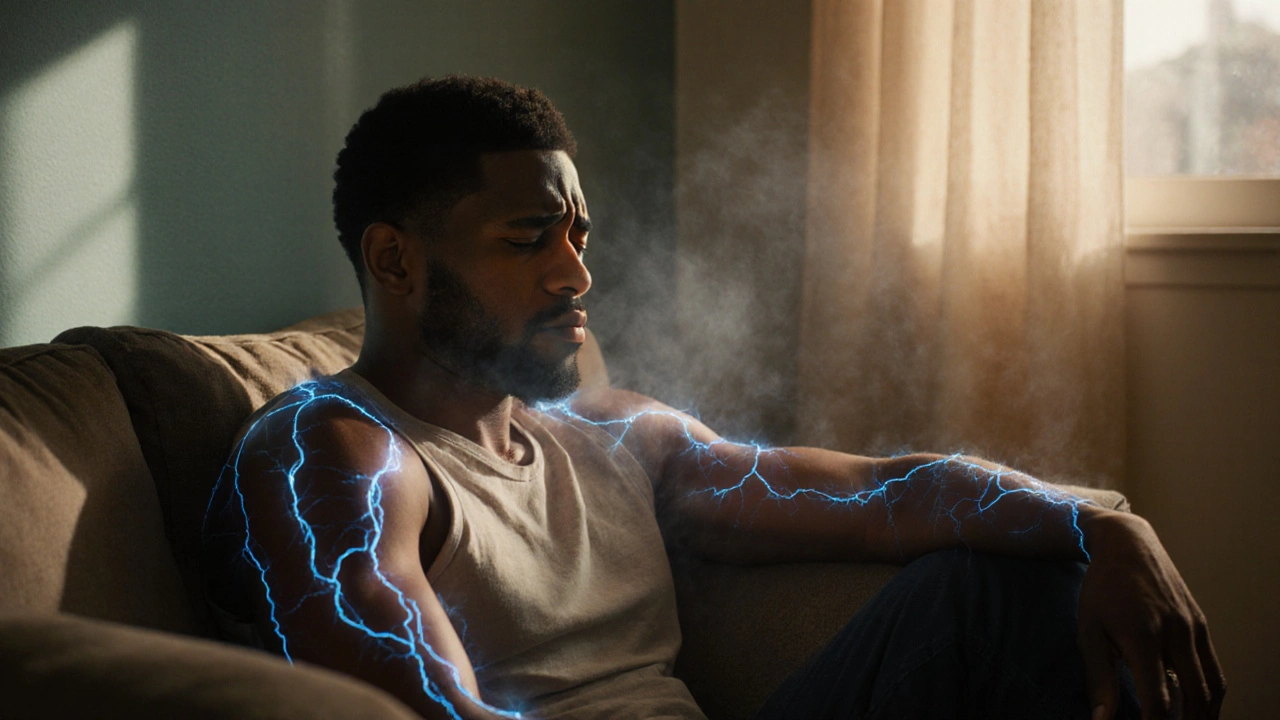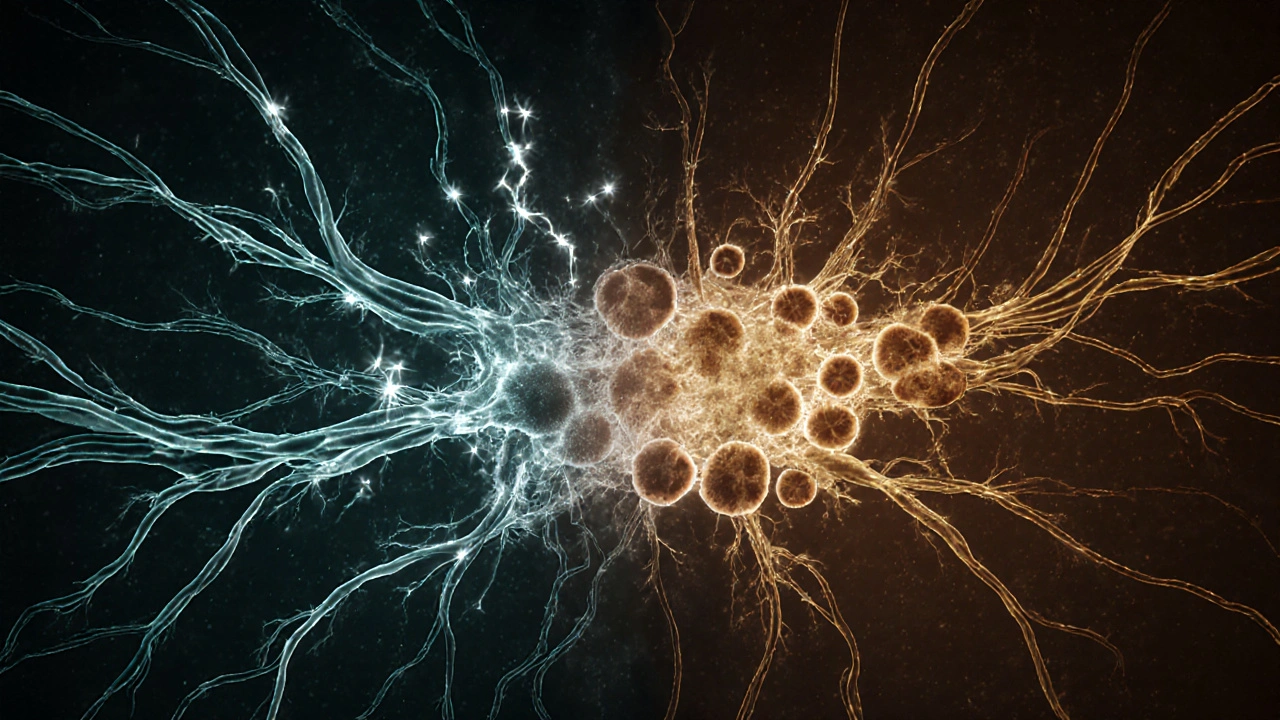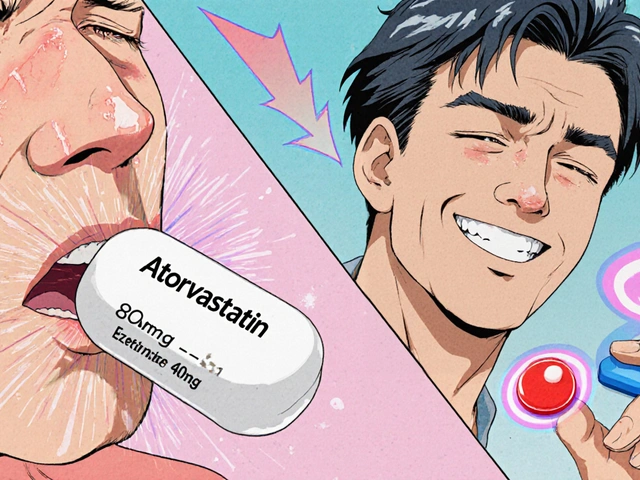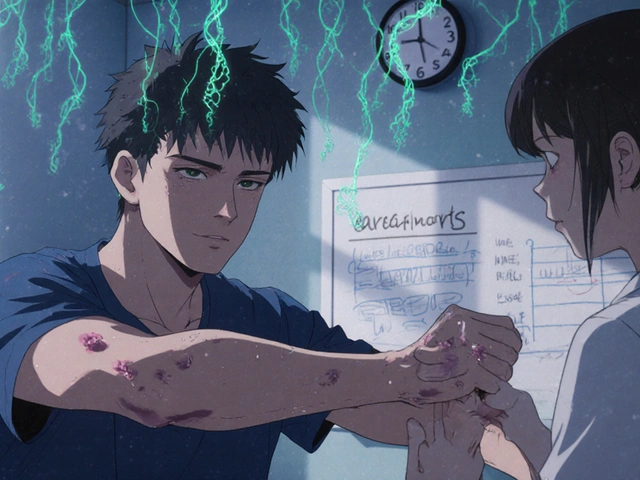Postherpetic Neuralgia is a chronic neuropathic pain condition that follows an outbreak of herpes zoster (shingles), characterised by burning, stabbing sensations that can persist for months or years after the rash heals. While many think of it as a skin‑related after‑effect, researchers now see it as part of a broader pain‑immune network that often overlaps with Chronic Fatigue Syndrome (a complex, multisystem disorder marked by debilitating fatigue, unrefreshing sleep and cognitive fog). This article untangles the connection, explains why patients sometimes experience both, and offers practical steps for clinicians and sufferers.
Why the Two Conditions Frequently Appear Together
Both Herpes Zoster (the viral reactivation that causes shingles) and Small Fiber Neuropathy (damage to the thin nerves that transmit pain and temperature) trigger a cascade of Neuroinflammation (the release of inflammatory cytokines within the nervous system). This inflammation not only fuels the burning pain of postherpetic neuralgia (PHN) but also disturbs autonomic regulation, leading to the profound fatigue seen in CFS.
Studies from 2023‑2024 report that up to 30% of PHN patients develop persistent fatigue that meets CFS criteria, while 15% of CFS cohorts recall a recent shingles episode. The shared driver appears to be Immune Dysregulation (an imbalance in cytokine production, especially elevated interleukin‑6 and tumor necrosis factor‑α). When the immune system stays in a heightened state, it exhausts neuronal energy reserves, resulting in both pain amplification and systemic tiredness.
Key Overlapping Mechanisms
- Peripheral nerve injury: The varicella‑zoster virus attacks dorsal root ganglia, damaging small fibers that also play a role in fatigue signalling pathways.
- Cytokine spillover: Elevated IL‑6, IL‑1β, and TNF‑α cross the blood‑brain barrier, increasing central sensitisation and disrupting sleep architecture.
- Autonomic dysfunction: Both conditions feature orthostatic intolerance, heart‑rate variability loss, and reduced baroreflex sensitivity, perpetuating exhaustion.
- Mitochondrial stress: Chronic inflammation impairs mitochondrial ATP production, a finding common in biopsies from PHN‑related skin lesions and CFS muscle samples.
Clinical Presentation: Spotting the Overlap
When a patient presents with persistent post‑shingles pain, ask about the following CFS‑associated red flags:
- Fatigue that is not relieved by rest and lasts >6months.
- Unrefreshing sleep-patients wake feeling as tired as before.
- Post‑exertional malaise (PEM)-a crash after mild physical or mental activity.
- Neurocognitive complaints-"brain fog," difficulty concentrating.
- Orthostatic symptoms-dizziness, light‑headedness on standing.
Conversely, a CFS patient reporting new‑onset burning limb pain after a rash should be evaluated for PHN. Early identification enables targeted therapy that can improve both pain and fatigue trajectories.
Management Strategies That Address Both Conditions
Effective treatment hinges on dampening neuroinflammation while supporting nervous‑system repair. Below is a concise checklist:
- Antiviral therapy: For PHN, a 7‑10day course of famciclovir or valacyclovir within 72hours of rash onset reduces viral load and may blunt subsequent fatigue.
- Neuropathic pain agents: Gabapentin (starting at 300mg nightly) or pregabalin (75mg BID) decrease ectopic firing in damaged fibers. Doses should be titrated to minimise sedation, which can worsen fatigue.
- Low‑dose tricyclic antidepressants (e.g., amitriptyline 10‑25mg HS) help both pain and sleep quality.
- Immune‑modulating supplements: Vitamin D (≥1000IU daily) and omega‑3 fatty acids have modest evidence for reducing pro‑inflammatory cytokines.
- Gradual activity pacing: Structured, low‑intensity exercise (e.g., seated cycling for 5‑10minutes, 3times/week) improves mitochondrial efficiency without triggering PEM.
- Cognitive‑behavioral strategies: Mindfulness‑based stress reduction lowers cortisol, indirectly reducing neuroinflammatory signaling.
Importantly, clinicians should avoid high‑dose opioids; they provide temporary pain relief but often increase fatigue and risk of dependence.
Comparison of PHN and CFS
| Attribute | Postherpetic Neuralgia | Chronic Fatigue Syndrome |
|---|---|---|
| Typical onset | Weeks after shingles rash resolves | Gradual, often after infection or stress |
| Primary symptom | Burning, stabbing neuropathic pain | Severe, persistent fatigue |
| Common secondary symptoms | Allodynia, sleep disturbance | Unrefreshing sleep, PEM, brain fog |
| Prevalence (UK) | ≈1% of adults over 60 | ≈0.4% of general population |
| First‑line treatment | Gabapentinoids, topical lidocaine | Activity pacing, CBT, sleep hygiene |
| Key pathophysiology | Neuroinflammation from VZV reactivation | Immune dysregulation + mitochondrial dysfunction |

Related Concepts and How They Interact
Understanding the PHN‑CFS link opens doors to a network of related topics that clinicians often explore:
- Autonomic Dysfunction (abnormal regulation of heart rate, blood pressure, and digestion) contributes to both orthostatic intolerance in CFS and vasomotor changes that aggravate PHN pain.
- Sleep Architecture Disruption (altered REM and deep‑sleep cycles) magnifies cytokine production, creating a vicious cycle of pain‑fatigue.
- Mood Disorders (depression and anxiety that often co‑occur) can lower pain thresholds and amplify perceived fatigue, so screening for these is essential.
- Quality of Life Measures (validated questionnaires such as SF‑36) help quantify the combined burden and track treatment response.
These concepts are not isolated; they feed into each other. For instance, neuroinflammation worsens sleep, which deepens autonomic dysfunction, which then fuels mood disturbances-creating a tangled web that only a holistic approach can untangle.
Practical Tips for Patients and Caregivers
- Maintain a symptom diary: note pain intensity, fatigue levels, sleep quality, and any triggers. Patterns often reveal the inflammatory peaks.
- Prioritise gentle movement: short walks, tai chi, or gentle yoga keep muscles active without over‑taxing the energy system.
- Adopt a consistent sleep schedule: dark, cool bedroom, no screens after 9pm, and a short wind‑down routine.
- Stay hydrated and keep a balanced diet rich in antioxidants (berries, leafy greens) to support mitochondrial health.
- Communicate with your GP about antiviral timing if shingles appears-early treatment may reduce both pain and later fatigue.
Future Directions in Research
Scientists are probing targeted anti‑cytokine agents (e.g., monoclonal antibodies against IL‑6) to see if they can simultaneously ease PHN pain and CFS fatigue. Small‑scale trials of low‑dose naltrexone have shown promise in modulating microglial activation, a key driver of neuroinflammation.
Meanwhile, advances in high‑resolution skin biopsies allow clinicians to quantify small‑fiber density, providing an objective marker that could predict who is at risk of developing fatigue after shingles. As biomarkers improve, personalised treatment pathways will likely replace the current trial‑and‑error approach.
Bottom Line
Postherpetic Neuralgia and Chronic Fatigue Syndrome are not strangers; they share a neuro‑immune axis that fuels both burning pain and relentless exhaustion. By recognising the overlap, tailoring therapies that calm inflammation, and supporting the nervous system’s repair mechanisms, patients can experience meaningful relief on both fronts.
Frequently Asked Questions
Can postherpetic neuralgia cause chronic fatigue?
Yes. The lingering inflammation after shingles can disrupt sleep, autonomic function and cytokine balance, all of which contribute to the debilitating fatigue that meets chronic fatigue syndrome criteria.
Is it normal for a CFS patient to develop shingles?
People with CFS often have immune dysregulation, making them more susceptible to viral reactivations such as herpes zoster. When shingles occurs, the risk of developing postherpetic neuralgia rises sharply.
What medication works for both pain and fatigue?
Low‑dose gabapentinoids (gabapentin or pregabalin) can lessen neuropathic pain and improve sleep, which indirectly reduces fatigue. However, dosing must be cautious to avoid sedation.
Are there any lifestyle changes that help both conditions?
Yes. Regular gentle exercise, consistent sleep‑hygiene, balanced nutrition rich in antioxidants, and stress‑reduction techniques like mindfulness can lower inflammatory markers, supporting both pain relief and energy restoration.
Should I see a neurologist or a rheumatologist?
Start with your GP; they can refer you to a neurologist for the neuropathic pain side and to a specialist in chronic fatigue (often a rheumatologist or a physician‑trained in ME/CFS) for the fatigue component. Collaborative care yields the best outcomes.








jennifer jackson
September 26, 2025 AT 18:37Stay hopeful you can manage both pain and fatigue.
Brenda Martinez
September 26, 2025 AT 20:40Oh, the tragedy of a world that refuses to acknowledge the cruel union of burning nerves and soul‑crushing exhaustion! You think you’ve read the literature, yet you’ve missed the hidden cascade of cytokines that turn a simple rash into a lifelong nightmare. The authors of that article barely scratched the surface, ignoring the deep‑seated immunological sabotage that keeps patients shackled. It’s an affront to anyone who has ever watched a loved one suffer in silence. Wake up and demand real science, not just a checklist of symptoms.
Marlene Schanz
September 26, 2025 AT 22:53i think it’s pretty wild how the zoster virus can mess with your nerves and then just drag you into fatigue mode. from my own experience, keeping a simple diary helped spot patterns that docs missed. also, staying chill and not over‑exerting yourself can stop the crash. yeah, it’s a bit of trial and error, but it works for many.
Matthew Ulvik
September 27, 2025 AT 01:40Hey there! Great point about pacing-starting with just 5‑minute walks can really boost energy without triggering PEM 😊. Also, low‑dose gabapentin often helps both pain and sleep, which is a win‑win.
Dharmendra Singh
September 27, 2025 AT 05:50It is important to recognize that cultural factors can influence how patients report pain and fatigue. In many Asian communities, stigma around chronic illness may lead to under‑reporting, which complicates diagnosis. Clinicians should take extra time to build trust and explain the neuro‑immune link clearly.
Rocco Abel
September 27, 2025 AT 10:00One must consider the hidden financial incentives driving the mainstream recommendations. The pharmaceutical lobby subtly nudges us toward gabapentinoids while downplaying natural anti‑inflammatory strategies, thereby ensuring perpetual market demand. Independent research suggests that low‑dose naltrexone could be a game‑changer, yet it remains suppressed.
Dawn Mich
September 27, 2025 AT 15:33Don't be fooled by the glossy pamphlets! The same agencies that profit from opioid sales are now pushing gabapentin as a miracle cure, all to keep patients dependent on endless prescriptions. It's a coordinated effort to monetize chronic misery, and we need to call it out now.
Eric Sevigny
September 27, 2025 AT 22:30Actually, a recent meta‑analysis showed that vitamin D supplementation can modestly lower IL‑6 levels, which may ease both pain and fatigue. Just make sure to check serum levels before megadosing.
Glenda Rosa
September 28, 2025 AT 05:26Honestly, the whole cytokine hype is overblown-most of the data is from tiny rat studies that don't translate to humans. Instead of chasing IL‑6 blockers, we should focus on lifestyle-proper nutrition, grounding, and good old‑fashioned sleep hygiene. The pharma‑driven narrative is just a smokescreen.
charlise webster
September 28, 2025 AT 13:46While the article emphasizes neuroinflammation, it's worth noting that autonomic dysfunction alone can explain many of the overlapping symptoms without invoking cytokine storms.
lata Kide
September 29, 2025 AT 00:53Can you believe the sheer drama of a virus turning your nerves into a fireworks show of pain and then stealing your energy? 🌩️🔥 It's like your body is staging a horror movie, and you're the unwilling star! 😱
Mark Eddinger
September 29, 2025 AT 14:46In reviewing the manuscript, it becomes evident that the authors have inconsistently applied the Oxford comma throughout the list of symptoms. Consistency in punctuation enhances readability and ensures that the enumeration of fatigue, pain, and cognitive disturbances remains unambiguous.
Francisco Garcia
September 30, 2025 AT 07:26I’ve been wondering how the gut microbiome might intersect with the neuro‑immune axis that the article describes. Could dysbiosis be a contributing factor to both PHN and CFS? If so, perhaps probiotic interventions deserve a spot in the treatment checklist.
Patrick Renneker
October 1, 2025 AT 02:53The intricate interplay between peripheral neuropathic insults and systemic fatigue syndromes constitutes a subject of paramount relevance to contemporary neuroimmunology. It is incumbent upon the discerning clinician to appraise not merely the somatic manifestations of post‑herpetic neuralgia but also the subtler, yet equally debilitating, phenotypic expressions of chronic fatigue. Recent longitudinal cohort analyses have elucidated a statistically significant correlation between the temporal onset of varicella‑zoster reactivation and subsequent elevations in circulating interleukin‑6 concentrations. Moreover, the persistence of small‑fiber neuropathy has been demonstrated to precipitate dysautonomic phenomena that, in turn, exacerbate orthostatic intolerance, a cardinal feature of the fatigue spectrum. The pathophysiological cascade is further amplified by mitochondrial bioenergetic compromise, as evidenced by diminished ATP synthase activity in affected dermal biopsies. While pharmacologic agents such as gabapentinoids provide appreciable analgesic benefit, their sedative propensities may inadvertently potentiate the very fatigue they aim to ameliorate. Consequently, a nuanced titration protocol, predicated upon objective sleep architecture assessments, is advocated. In parallel, the burgeoning body of evidence supporting low‑dose naltrexone as a microglial modulator warrants rigorous, double‑blind investigation. Equally salient is the role of non‑pharmacological interventions, notably graded exercise therapy, which must be judiciously calibrated to circumvent post‑exertional malaise. Nutritional optimization, through the incorporation of omega‑3 fatty acids and vitamin D, has been associated with modest reductions in pro‑inflammatory cytokine flux. It is also prudent to acknowledge the psychosocial dimensions of chronic illness, wherein stigmatization may impede patient adherence to therapeutic regimens. A multidisciplinary framework, integrating neurology, rheumatology, and behavioral health, therefore emerges as the optimal paradigm for comprehensive management. Future investigative trajectories should prioritize the identification of reliable biomarkers capable of delineating patient subsets most susceptible to concomitant PHN‑CFS pathology. Advanced imaging modalities, such as functional MRI coupled with neuroinflammatory tracers, hold promise in this regard. In summation, the confluence of neuroinflammatory, autonomic, and metabolic perturbations mandates an integrative therapeutic strategy that transcends monotherapeutic dogma. Only through such a holistic approach can clinicians aspire to mitigate the dual burden of chronic pain and inexorable fatigue.
KAYLEE MCDONALD
October 2, 2025 AT 01:06Remember you’re not alone-small steps and support can make a real difference.